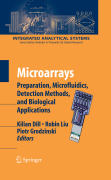
Microarrays: preparation, microfluidics, detection methods, and biological applications
Dill, K.
Liu, R.
Grodzinsky, P.
Combinatorial chemistry is used to find materials that form sensor micoarrays. This book discusses the fundamentals, and then proceeds to the many applications of microarrays, from measuring gene expression (DNA microarrays) to protein-protein interactions, peptide chemistry, carbodhydrate chemistry, electrochemical detection, and microfluidics. Application of combinatorial chemistry tosensor materials No competition whatsoever One of the first books in the series Integrated Microanalytical Systems INDICE: From the contents Types of arrays currently available.- Optical methods of detection of events on the chip surface.- Electrochemical Detection.-Integrated Microfluidic Devices for Automating DNA Microarray Process.- Self-contained, Fully Integrated Biochip for Sample Preparation, PCR Amplification,and DNA Microarray Detection.- Spot identification and data evaluation.- Statistical data analysis.- Electrochemical output and data analysis.- Uses of DNAMicroarrays.- Peptide Arrays: towards Routine Implementation.- Antibody Microarrays for the Detection of Toxins.- Autoantibody Profiling Using Synovial Proteome Microarrays.- Carbohydrate microarrays for the Recognition of Microbes and Host Cells.- Development of the Living Cell Array.- Assembly of Multicellular Cell Microarrays Using Magnetic Nanowires.- Combinatorial Organic Chemistryfor Future Drug Development and Screening.- Cystic Fibrosis Carrier ScreeningTest Performed Using a Microarray Platform Based on Electrochemical Detectionof DNA Hybridization.
- ISBN: 978-0-387-72716-5
- Editorial: Springer
- Encuadernacion: Cartoné
- Páginas: 310
- Fecha Publicación: 01/01/2009
- Nº Volúmenes: 1
- Idioma: Inglés
